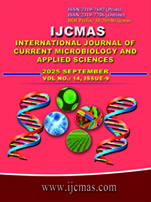Assessment of Heavy Metal Concentrations in Ambient Air of Bhubaneswar, India
Somen Das1*, Hemanta Kumar Patra2 and Bijaya Kumar Padhi3
1Department of Botany, Utkal University, India 2Department of Community Medicine & School of Public Health, Postgraduate Institute of Medical Education and Research (PGIMER),Chandigarh-160012, India
*Corresponding author
Abstract:
A study was carried out to determine the concentration of heavy metals like cadmium, Copper, Nickel, Zinc, Lead, Manganese and Iron present in ambient air of capital city of Odisha, Bhubaneswar. Simultaneously particulate matter like PM10 and PM2.5 and gaseous pollutants like SO2, NOx, O3, and NH3 were also monitored on seasonal basis while heavy metals were collected once a year. The obtained results were reflected and compared with the Ambient Air Quality standards prescribed by the Minister of Environment and Forest (MoEF). The concentration of lead at all locations was found to be within the limits i.e. 0.5 µg/m3. Similarly nickel concentration was also detected below the limit i.e. 20 µg/m3. In the ambient air of Bhubaneswar heavy metals like cd is in the range of 0.0036-0.0084, Cu-0.0079-0.0136, Ni-0.0173-0.02554, Zn-0.1213-0.1641, Pb-0.1259-0.2492, Mn-0.10058-0.145, Fe-1.2767-1.7158. From the study it was found that the concentration of heavy metals in the ambient air is low except iron. The seasonal range and annual average of particulate matter as well as gaseous pollutants of all the locations were calculated and compared with the Ambient Air Quality Standards (NAAQMS, 2005).
Keywords: Heavy metals, Pollutants, Air quality standards, Particulate matter
References:
- Aggarwal P, Jain S. Impact of air pollutants from surface transport sources on human health: a modeling and epidemiological approach. Environ Int. 2015; 83:146–157. doi: 10.1016/j.envint.2015.06.010.
- Bao R, Zhang A. Does lockdown reduce air pollution? Evidence from 44 cities in northern China. Sci Total Environ. 2020; 731:139052. doi: 10.1016/j.scitotenv.2020.139052.
- Dutkiewicz VA, Alvi S, Ghauri BM, Choudhary MI, Husain L. Black carbon aerosols in urban air in South Asia. Atmos Environ. 2009; 43(10):1737–1744. doi: 10.1016/j.atmosenv.2008.12.043.
- Gaur A, Tripathi SN, Kanawade VP, Tare V, Shukla SP. Four-year measurements of trace gases (SO2, NOx, CO and O3) at an urban location, Kanpur, in Northern India. J Atmos Chem. 2014; 71:283–301. doi: 10.1007/s10874-014-9295-8.
- Ghosh D, Midya SK, Sarkar U, Mukherjee T. Variability of surface ozone with cloud coverage over Kolkata, India. J Earth Syst Sci. 2015; 124:303–319. doi: 10.1007/s12040-015-0543-3.
- Jain S, Sharma T. Social and travel lockdown impact considering coronavirus disease (COVID-19) on air quality in megacities of India: present benefits, future challenges and way forward. Aerosol Air Qual Res. 2020; 20:1222–1236. doi: 10.4209/aaqr.2020.04.0171.
- Lal S, Naja M, Subbaraya BH. Seasonal variations in surface ozone and its precursors over an urban site in India. Atmos Environ. 2000; 34:2713–2724. doi: 10.1016/S13522310(99)00510-5.
- Mallik C, Lal S, Venkataramani S. Trace gases at a semi-arid urban site in western India: variability and inter-correlations. J Atmos Chem. 2015; 72:143–164. doi: 10.1007/s10874-015-9311-7.
Download this article as 
How to cite this article:
Somen Das, Hemanta Kumar Patra and Bijaya Kumar Padhi 2025. Assessment of Heavy Metal Concentrations in Ambient Air of Bhubaneswar,
Int.J.Curr.Microbiol.App.Sci. 14(9): 195-200. doi:
https://doi.org/10.20546/ijcmas.2025.1409.021
 Citations
Citations



 National Academy of Agricultural Sciences (NAAS)
National Academy of Agricultural Sciences (NAAS) 




